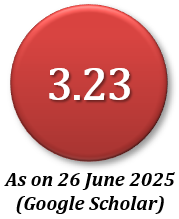Computational Design Approach to Re-Establish the Urban Fabric of Mongla: A Perspective from Grasshopper
Abstract
The Padma Multipurpose Bridge Project is the genesis of some subsequent projects in Bangladesh among which developing Mongla Port is one of the priority values. Since Mongla is an integral part of southern Bangladesh, the government has taken initiatives to integrate the port uses for neighboring countries. An agreement was signed (Intra Bangladesh, Butan, India, and Nepal (BBIN) Trade) for offering multi‐modal transit access to India and Port access to Nepal, Bhutan and Eastern India. The objective of this study is to establish a computational way to analyze the existing fabric and restore a potential optimized fabric. The methodology of this study includes developing a computational approach, collecting data from secondary sources, analyzing the data set and adjusting it to the identified existing urban fabric. In this paper, a new tool is introduced named ‘Physarealm’, based on the algorithm of Grasshopper and Rhinoceros.
Downloads
References
Acharjee Deepak, (2020), The Independent, February 5th, Four metropolitan cities to turn into ‘smart cities’ Rhinoceros 3d application. Source: https://en.wikipedia.org/wiki/Rhinoceros_3D, Extracted on July 21, 2021.
Apps for Rhino and Grasshopper, Source: https://www.food4rhino.com/en/app/physarealm, Extracted on July 21, 2021.
Batty M., (2001) ‘‘Exploring isovist fields: Space and shape in architectural and urban morphology,’’ Environ. Planning B, vol. 28, no. 1, pp. 123–150.
Conroy-Dalton R. & Bafna S., (2003) ‘‘The syntactical image of the city: A reciprocal definition of spatial elements and spatial syntaxes,’’ in Proc. 4th Int. Space Syntax Symp., pp. 59.1–59.22.
Detailed Area Plan [Mongla] Port Paurashva DAP.
Executive summary draft: pre-feasibility report Mongla Economics Zone Bangladesh/pp 32-33
Fink T., Koenig R. (2019), Data - city information modelling and GIS - Volume 3 - eCAADe 37 / SIGraDi 23, pp 313
Hausleitner B., (2010) ‘‘Tracing scopes of action. Approaching the complexity of the urban block,’’ M.S. thesis, EMU, Delft, The Netherlands.
Koenig R., Knecht K., Buš P., (2017) Koenig R. et al “Interactive Urban Synthesis- Computational Methods for Fast Prototyping of Urban Design Proposals”.
Li X. et al. (2016): Assessment of Urban Fabric for Smart Cities.
Mawla A.,Schneider S., Bielik M., Koenig R. (2018), Integrated Data Analysis for Parametric Design
Environment, mineR: a Grasshopper plugin based on R 36th eCAADe Conference - Computing for a better tomorrow pp. 320
Motta, E 1999, Reusable Components for Knowledge
Modelling: Case Studies in Parametric Design Problem Solving, IOS Press.
Nakagaki, T., Yamada, H. and Toth, A.: (2000), Intelligence: Maze-solving by an amoeboid organism, Nature, pp. 470-470.
Pantic, I. and Hahm, S.: 2015, Isomorphic Agency, Emerging Experience in Past, Presentand Future of Digital Architecture, Proceedings of the 20th International Conference of the Association for Computer-Aided Architectural Design Research in Asia CAADRIA, pp.178-188
Polsky C. et al. (2014), ‘‘Assessing the homogenization of urban land management with an application to US residential lawn care,’’ Proc. Nat. Acad. Sci. USA. vol. 111, no. 12, pp. 4432–4437,
Pre-Feasibility Report-Mongla Economic Zone, Bangladesh. (2015), pp 139-140.
Proshansky H. M., Fabian A. K., and Kaminoff R., (1983), ‘Place-identity: Physical world socialization of the self,’ J. Environ. Psychol., vol. 3, no. 1, pp. 57–83.
Rahman f. & Kuhl L. (2021) “Putting Mongla on the Map: The Curious Case of a Coastal Secondary City’s Transformation”. In United Nations Research Institute for Social Development. Source: https://www.unrisd.org/transformation-mongla, Extracted on July 20, 2021.
Renner, R (2018), Urban Being, Anatomy & identity of the city, Salenstein.
Ruan Y., and Gu X., (2004) ‘‘An analysis about the practical patterns to conserve the historic districts in China,’’ J. Tongji Univ. Soc. Sci., vol. 15, no. 5, pp. 1–6.
Schneider, C., Koltsova A., Schmitt G, ETH Zurich. (2011) “Components for Parametric Urban Design in Grasshopper. From Street Network to Building Geometry”/pp 68
Spring Simulation Multi-conference, SpringSim '11, Boston, MA, USA.
Status paper on Asian highway Bangladesh (2011), Roads Division, Ministry of Communications Bangladesh.
Tero, A., Kobayashi, R. and Nakagaki, T.: (2007), A mathematical model for adaptive transport network in path finding by true slime mold, Journal of theoretical biology, pp. 553-564
The Preparatory Study on the Dhaka Mass Rapid Transit Development Project (TOD), Final Report, pp-3_158
Trancik R., (1986), Finding Lost Space: Theories of Urban Design. New York, NY,
Volume 8: Proceedings of the 2011 Symposium on Simulation for Architecture and Urban Design (SimAUD).
Yidong M., Weiguo X., (2017), Proceedings of the 22nd International Conference of the Association for Computer-Aided Architectural Design Research in Asia (CAADRIA) 2017, pp 499-509.
MIJST follows the open access policy.

This work is licensed under a Creative Commons Attribution-NonCommercial 4.0 International License. This allows anyone to copy, share, distribute, and modify the work for non-commercial purposes, where the original work and source should be properly credited.
















